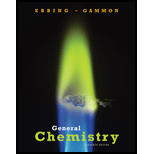
Concept explainers
(a)
Interpretation:
The complete balanced equation for the given incomplete reaction has to be written.
Concept Introduction:
Balanced Chemical equation:
A balanced chemical equation is an equation which contains same elements in same number on both the sides (reactant and product side) of the chemical equation thereby obeying the law of conservation of mass.
(a)
Answer to Problem 21.93QP
Explanation of Solution
To Write: The complete balanced equation for the given incomplete reaction.
Potassium and bromine reacts together and forms potassium bromide precipitate.
The balanced equation is given as follows,
Bromine molecule has two bromine atoms and the product potassium bromide has one bromine atom. Potassium bromide needs coefficient two and potassium in reactant side gets coefficient two. Now in both sides the elements are balanced.
(b)
Interpretation:
The complete balanced equation for the given incomplete reaction has to be written.
Concept Introduction:
Balanced Chemical equation:
A balanced chemical equation is an equation which contains same elements in same number on both the sides (reactant and product side) of the chemical equation thereby obeying the law of conservation of mass.
(b)
Answer to Problem 21.93QP
Explanation of Solution
To Write: The complete balanced equation for the given incomplete reaction.
Potassium reacts with water to forms potassium hydroxide solution and hydrogen gas.
The balanced equation is given as follows,
Before including coefficients there are two hydrogens, one oxygen and one potassium in reactant side and there are three hydrogens, one oxygen and one potassium. Water and potassium gets coefficient two in reactant side and potassium hydroxide gets two in product side. Now in both sides the elements are balanced.
(c)
Interpretation:
The complete balanced equation for the given incomplete reaction has to be written.
Concept Introduction:
Balanced Chemical equation:
A balanced chemical equation is an equation which contains same elements in same number on both the sides (reactant and product side) of the chemical equation thereby obeying the law of conservation of mass.
(c)
Answer to Problem 21.93QP
Explanation of Solution
To Write: The complete balanced equation for the given incomplete reaction.
Sodium hydroxide reacts with carbon dioxide to form sodium carbonate precipitate and water as side product.
The balanced equation is given as follows,
Sodium hydroxide in reactant side gets coefficient two because obtained product sodium carbonate has two sodium atom. Now in both sides the elements are balanced.
(d)
Interpretation:
The complete balanced equation for the given incomplete reaction has to be written.
Concept Introduction:
Balanced Chemical equation:
A balanced chemical equation is an equation which contains same elements in same number on both the sides (reactant and product side) of the chemical equation thereby obeying the law of conservation of mass.
(d)
Answer to Problem 21.93QP
Explanation of Solution
To Write: The complete balanced equation for the given incomplete reaction.
Lithium carbonate reacts with nitric acid which gives lithium nitrate, water and carbon dioxide.
The balanced equation is given as follows,
Lithium nitrate and nitric acid gets coefficient two because lithium carbonate has two lithium atoms and water has two hydrogen atoms. Now in both sides the elements are balanced.
(e)
Interpretation:
The complete balanced equation for the given incomplete reaction has to be written.
Concept Introduction:
Balanced Chemical equation:
A balanced chemical equation is an equation which contains same elements in same number on both the sides (reactant and product side) of the chemical equation thereby obeying the law of conservation of mass.
(e)
Answer to Problem 21.93QP
Explanation of Solution
To Write: The complete balanced equation for the given incomplete reaction.
Potassium sulphate reacts with potassium nitrate which gives lead sulfate and potassium nitrate.
The balanced equation is given as follows,
Lead nitrate has two nitrate ions, thus potassium nitrate gets coefficient two in order to balance the equation. Now in both sides the elements are balanced.
Want to see more full solutions like this?
Chapter 21 Solutions
General Chemistry
- Give the formula for the acidic oxide of (a) HNO3 (b) HNO2 (c) H2SO4arrow_forwardThe reaction of calcium hydride, CaH2, with water can be characterized as a Lewis acid-base reaction: CaH2(s)+2H2O(l)Ca(OH)2(aq)+2H2(g) Identify the Lewis acid and the Lewis base among the reactants. The reaction is also an oxidation-reduction reaction. Identify the oxidizing agent, the reducing agent, and the changes in oxidation number that occur in the reaction.arrow_forwardWhich is the stronger acid, HClO4 or HBrO4? Why?arrow_forward
- How many grams of oxygen gas are necessary to react completely with 3.011021 atoms of magnesium to yield magnesium oxide?arrow_forwardWrite balanced chemical equations for the following reactions: (a) cadmium burned in air. (b) elemental cadmium added to a solution of hydrochloric acid. (c) cadmium hydroxide added to a solution of acetic acid, CH3CO2Harrow_forward
 Chemistry: An Atoms First ApproachChemistryISBN:9781305079243Author:Steven S. Zumdahl, Susan A. ZumdahlPublisher:Cengage Learning
Chemistry: An Atoms First ApproachChemistryISBN:9781305079243Author:Steven S. Zumdahl, Susan A. ZumdahlPublisher:Cengage Learning ChemistryChemistryISBN:9781305957404Author:Steven S. Zumdahl, Susan A. Zumdahl, Donald J. DeCostePublisher:Cengage Learning
ChemistryChemistryISBN:9781305957404Author:Steven S. Zumdahl, Susan A. Zumdahl, Donald J. DeCostePublisher:Cengage Learning
 Chemistry by OpenStax (2015-05-04)ChemistryISBN:9781938168390Author:Klaus Theopold, Richard H Langley, Paul Flowers, William R. Robinson, Mark BlaserPublisher:OpenStax
Chemistry by OpenStax (2015-05-04)ChemistryISBN:9781938168390Author:Klaus Theopold, Richard H Langley, Paul Flowers, William R. Robinson, Mark BlaserPublisher:OpenStax Chemistry: Principles and ReactionsChemistryISBN:9781305079373Author:William L. Masterton, Cecile N. HurleyPublisher:Cengage Learning
Chemistry: Principles and ReactionsChemistryISBN:9781305079373Author:William L. Masterton, Cecile N. HurleyPublisher:Cengage Learning Chemistry: Principles and PracticeChemistryISBN:9780534420123Author:Daniel L. Reger, Scott R. Goode, David W. Ball, Edward MercerPublisher:Cengage Learning
Chemistry: Principles and PracticeChemistryISBN:9780534420123Author:Daniel L. Reger, Scott R. Goode, David W. Ball, Edward MercerPublisher:Cengage Learning





